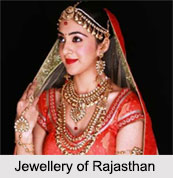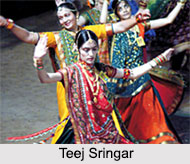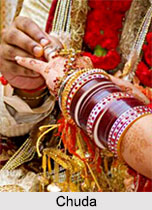 The jewellery in Rajasthan has been acquiring a special position amongst fashionable women since ages. Besides, royal Rajasthani women, these jewelleries are used and possessed by people from all over India. Continuity and the co-existence of India"s urban civilization and tribal cultures have bestowed a particular cultural identity to the traditional jewellery of Rajasthan. This is especially authentic in Rajasthan, where master-craftsmen in the urban centres enjoyed royal patronage and, thus, were able to develop their skills and imagination to create beautiful pieces of jewellery. On the other hand, tribal and rural communities of Rajasthan remain rooted in their traditions. Today, jewellery frames the context of its wearer`s social status.
The jewellery in Rajasthan has been acquiring a special position amongst fashionable women since ages. Besides, royal Rajasthani women, these jewelleries are used and possessed by people from all over India. Continuity and the co-existence of India"s urban civilization and tribal cultures have bestowed a particular cultural identity to the traditional jewellery of Rajasthan. This is especially authentic in Rajasthan, where master-craftsmen in the urban centres enjoyed royal patronage and, thus, were able to develop their skills and imagination to create beautiful pieces of jewellery. On the other hand, tribal and rural communities of Rajasthan remain rooted in their traditions. Today, jewellery frames the context of its wearer`s social status.
Jewellery in Rajasthan also serves the purpose of distinguishing one socio-ethnic group from the other one. Several laws were enacted, which clearly restricted the use of the metal in the jewellery of Rajasthan. Royalty alone had the power to display gold ornaments anywhere on their person, whereas the rest of the social classes were allowed to wear gold only from the waist up. All other sections of society were permitted the use of gold in strict moderation, for instance, only in case of nose rings. Otherwise, it was believed that the purity of this precious metal would be tarnished. Thus society in the region was further divided by the wearing of gold.
 Significance of Jewellery in Rajasthan
Significance of Jewellery in Rajasthan
The jewellery of Rajasthan is much like costume, which is the manifestation of refined design and skill that has evolved by a civilisation over the millennia. The vast and diverse range of jewellery exists especially in the present day as an indication of the creativity and aesthetic consciousness of the Indian craftsperson, as also the innate desire for personal ornamentation. The association between ornaments and religion is very strong in the norms of Rajasthan. Particular pieces of jewellery and even the material declare the religious affinities of a group.
Apart from its symbolic value, the jewellery of Rajasthan is also an important investment because of its easy liquidity. This is especially true in this region with its harsh desert environment, its unremitting internecine warfare and history of turbulent political upheaval. Feudalism, invasions and instability made it essential to accumulate movable assets for security. The precious jewellery in Rajasthan was also an evaluation of survival.
Jewellery for Women in Rajasthan
Rajasthan has a rich living tradition of jewellery for women. It has its ornaments, motifs and designs, which are native to its people and are worn even today. There are different kinds of jewellery for the hand, neck, forehead, ear, nose, arms, ankles, feet, waist and head in Rajasthan. The designs carved on these ornaments make the pieces exquisite. Native crafts like Kundan, Meenakari, Filigree and others are employed to design the jewelleries of Rajasthan.
 Crafting of Jewellery in Rajasthan
Crafting of Jewellery in Rajasthan
The Soni community is the traditional jewellers of Rajasthan. They use a multitude of materials, both organic and inorganic, from which they create beautiful jewellery. Although the jewellery in Rajasthan is crafted from a wide variety of metals, gold and silver are the most popular. Silver has always been the unmatched favourite in Rajasthan, as it is found in great abundance in the region. Gemstones like diamonds, rubies, pearls, sapphires and emeralds are also widely used for making jewellery in Rajasthan. Grass, straw and feathers are other materials that are widely used for ornamentation by the tribal people. Cowrie shells are used to decorate women"s hairpieces.
Lacquer or lac, aptly termed as "the common man"s gold" is greatly admired in Rajasthan. It is also considered extremely promising and auspicious by certain communities like the Bishnoi. Today, the lacquer bangles are hugely popular for special occasions like family weddings, Teej and other festivals. The lacquer bangles are made through an interesting process, with natural materials.
The coarse lac is initially melted down and overwrought through a muslin cloth. The residue obtained is called "Chapadi". The next stage involves the preparation of the "Guni" and "Batti". Guni is the lac stick and it is prepared by heating together coarsely pounded lac, beroza powder and crushed soapstone. These are finally rolled on to a wooden stick. In order to make the batti or colour cake, the chapadi is initially softened by heating and coloured powder is added. This mixture is kneaded, heated a little and cut into small cakes. Immersion in water then cools these cakes and a wooden stick is attached. Once the guni and batti are prepared, the batti is heated and rolled onto the surface of the guni. Several coatings are made so that the guni gets a generous amount of colour. This coloured guni is then heated and pressed into an unbroken column with a tool, known as "hatta" in their native language. This column is cut to get bangles of the needed size.
Almost two centuries of colonisation could not change the Rajasthani tradition of jewellery as daily wear. While its use as ornamentation may not be so routinely noticeable in urban India, it is still an indispensable part of the everyday attire of the rural Indian.





















